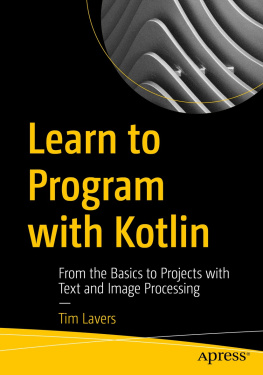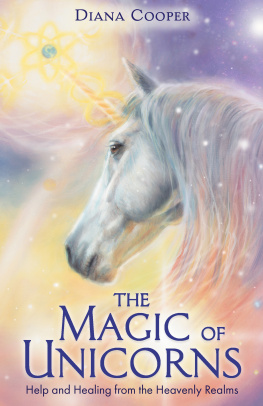There are two things to avoid in dealing with a legend. The first is to make too much of it, the other is to disbelieve it entirely.
T he unicorn in your head depends on your background. If you are steeped in the Christian tradition you may conjure up a small, gentle, goatlike animal, perhaps cradled in a womans lap. If your upbringing was secular you may imagine a muscular, noble, equine creature, perhaps facing a lion on a coat of arms. If you have read your children to sleep or dallied with New Age mysticism your unicorn is most likely a soft-focus, airbrushed, magical beast, perhaps with a crystal about its person. At once we see that the unicorn has different faces. It has more than it presently shows.
Unicorn scholarship is almost as old as the beast itself, and what a tangled mess it is. Many have tried to track the unicorns progress, and a few have glimpsed madness along the way. No attempt at a complete history will be found here. This book has more modest goals: to say a few things about the unicorn that have not been said before-on reflection, quite an ambitious aim-and to draw attention to the myths natural history. Many animals have been caught up in the unicorns story. The Indian rhinoceros, that archetypal one-horned quadruped, can often be seen in the beasts shadow. Most people know which animal supplied the unicorns horn. But who would have thought that the unicorn was related to the walrus? Or the mammoth? Or the orang-utan? On the fringes of the unicorns tale lurk animals that are fascinating in themselves, and whose connections with our myth-making reveal much about our engagement with the natural world.
So to follow the unicorn is to track one aspect of mankinds progress across 2500 years. It is a windy road with many charming vistas, and many strange ones. Before stepping out on it let us deal with one negative expectation that might otherwise spoil the journey. For most of recorded history people thought that the unicorn existed. Recently we have come to know that it never did. So this book must end in disappointment. Not so. Unicorns did exist. There are photographs.
A curious account of a one-horned beast was written in 398 BC or thereabouts by Ctesias of Cnidus. To this man we owe a legend that has lasted in the Western imagination for more than 2000 years.
There are in India certain wild asses which are as large as horses, and larger. Their bodies are white, their heads dark red, and their eyes dark blue. They have a horn on the forehead which is about a foot and a half in length. The base of this horn, for some two hands-breadth above the brow, is pure white; the upper part is sharp and of a vivid crimson; and the remainder, or middle portion, is black. Those who drink out of these horns, made into drinking vessels, are not subject, they say, to convulsions or to the holy disease [epilepsy]. Indeed, they are immune even to poisons if, either before or after swallowing such, they drink wine, water, or anything
Little is known for certain about Ctesias, but stitching together biographical fragments reveals the basic picture of his life.
Ctesias was a Greek native of Caria, a region in the far southwest of present-day Turkey, who spent nearly two decades in Persia, an empire centred on what is now Iran. Persia and Greece had a bloody history, the former having narrowly failed to overrun the latter in the Greco-Persian War of 490 to 479 BC . Though the two sides signed a truce in 449 BC it was never an easy one, and power struggles over settlements on Asias Mediterranean coast were commonplace. Ctesias was probably captured during one such dispute, but records are so vague that we cannot be sure even of that. Whatever the circumstances Persia had been gifted a prize, for Ctesias was a physician with an impeccable provenance: his home town of Cnidus was a renowned centre of medical learning in the ancient world. While resident in Persia Ctesias ministered to the king and his court. From this we may surmise that he was highly respected, because the king of Persia, the most powerful man in the world, commanded the services of the best.
Like his more famous predecessor Herodotus, Ctesias had a characteristically Greek curiosity about exotic peoples and places, and when not attending kings and courtiers seems to have had the time and freedom to conduct a lot of what he considered to be, and later presented as, research-though not everyone since has rated his efforts as highly. So intrigued was he about Persian and Assyrian history that he amassed enough material to write twenty-three chapters on the subject. And his curiosity stretched much further. At the eastern edge of Persias domain lay a land that was the most fascinating and magical of all: India. Greece was the pinnacle of literate culture in 400 BC and Persia the powerhouse of international politics, but far-away India was, by the few reports of it, a tangle of wonders beyond imagining.
Though fascinated by everything Indian, and in spite of the opportunities offered by Persias eastern borders, Ctesias never visited the subcontinent. Perhaps his medical duties prevented him from going. More realistically, Ctesias seems to have been a library type of fellow, a note-taker, a story-sponge, and not an adventurer.
Picture Ctesias rummaging in the Persian state archives, uncovering history never before seen by a Greek. Imagine him wandering wide-eyed through the streets of the Persian capital: everywhere the chatter of strange languages. If only he could understand what was being said, all the knowledge of the East would be his. Perhaps Ctesias employers granted him their interpreters to indulge his intellectual hobbies, or perhaps he hired interpreters himself; either way, from Persian officials who had visited India, from Indian traders, from visitors to the royal court, Ctesias knowledge of the lands beyond even Persias influence grew and grew.
In 398 or 397 BC Ctesias returned to the Mediterranean. Perhaps homesickness finally overcame him. At last he had time to write up his research. His magnum opus was on the history of Persia. He also wrote a few minor works, known to us only from fragments reported by later authors. And then there was Indica, a rich and In Indica Ctesias describes dog-faced people, fountains filled with liquid gold, mountain-dwelling griffins, tribes of one-legged men, pygmies with genitals hanging down to their ankles, and much else of wonder besides. Not surprisingly, scholars throughout history have branded Ctesias a fantasist and liar. If the nonsense in Indica came from Ctesias imagination then the good doctor was indeed a fantasist and liar, but if he simply wrote down exotic travellers tales we must judge him an honest, if perhaps slightly gullible, reporter.
It turns out that many of Ctesias stories can be traced to Indian epics, sacred writings, folk-tales, and real animals and plants. Tellingly, when he writes about real things he usually does a good job. His account of the elephant is quite precise. He also describes a brightly coloured bird that he had heard speaking Indian, and speculates that the animal might have been able to speak Greek. Ctesias is describing a parrot, and doing it rather well. And even when he is inaccurate we can sometimes see through his mistakes. The giant toothed worm that lives in the mud of river beds by day and devours cows and camels by night is probably a crocodilian of some sort. The fearsome martikhora is as big as a lion, has a face like a mans and a tail like a scorpions from which it fires stings. Absurd until martikhora is translated into Greek, whereupon it becomes man-eater. Ctesias goes on to say that these animals are numerous in India and hunted by natives riding on elephants. The martikhora would appear to be a tiger, or rather a cautionary tale about tigers that Indians employed to discourage children from playing within sting-range of the forest.











